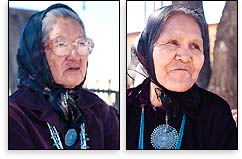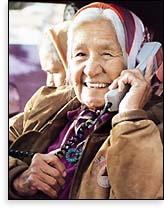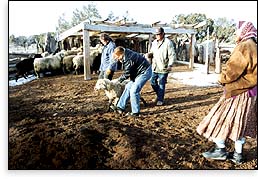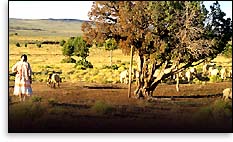
|

“One of the Worst Cases of Involuntary Community Resettlement”
It has been estimated that one-quarter of those displaced during the late 1970s as a result of the Settlement Act died within six years. Indeed, Leon Berger, executive director of the Navajo-Hopi Indian Relocation Commission, was moved to resign in January 1982 by the enormity of the disaster then unfolding, stating, “the forcible relocation of over 10,000 Navajo people is a tragedy of genocide and injustice that will be a blot on the conscience of this country for many generations.”
Thayer Scudder, professor of anthropology at California Institute of Technology, widely considered one of the world’s foremost experts on relocation, condemned the removal of the Navajo as “one of the worst cases of involuntary community resettlement that I have studied throughout the world over the past 40 years.” In January 1998 he appealed for relief for those remaining, stating that “Certainly no further forced removal should be required.”
In addition to steep human costs, the environmental concerns of Fred Johnson and others, it turns out, were well-founded.
Not only has the Black Mesa mine become a mammoth source of air and water pollution, but the slurry pipeline that carries coal 300 miles to Laughlin, Nevada, for conversion to electric power is reported to draw some 1.3 billion gallons of water per year — more than 2,400 gallons a minute — from the aquifer that is the region’s only water source, alarming Hopi and Navajo alike by lowering the water table and threatening virtually all life in the region. At least 50 springs have already dried up — an ominous loss to a desert-dwelling community. Tests also show that wells and springs in the area now contain high levels of such toxins as arsenic, copper and lead, explaining why numerous livestock have died after drinking the water.
Incredibly, the people most directly affected by the Settlement Act were neither allowed to testify nor to have representation in the Congressional hearings that preceded the forced removal.
“Very Subversive Stuff”
Marsha Monestersky, consultant to the Navajo and co-chair of the Human Rights Caucus for the United Nations Commission on Sustainable Development, is another voice adamant that the “land dispute” was contrived by commercial interests intent on procuring coal leases.
Monestersky, Blackgoat and others blame Peabody and the industrial behemoths that consume its coal, such as Southern California Edison, in addition to the BIA for the travails that have devastated traditional Navajo culture in the Big Mountain area.
While Peabody Group Vice President Vic Svec told Freedom that the company has no plans to mine at Big Mountain, critics have charged this is not the case. “He must be paid to lie,” Arlene Hamilton said, pointing out that a Hopi official recently admitted a new lease is possible after the Navajo had been moved out.
Meanwhile, through the years, supporters of the Navajo have encountered mysterious opposition. Laurie Scott, producer of the “Drums Across America” concert in Los Angeles in 1986 to benefit those at Big Mountain when a previous relocation deadline loomed, reported harassment and outright sabotage of an event that featured such stars as Stevie Wonder, Bonnie Bramlett, Paul Butterfield, Rita Coolidge, Richie Havens and Richard “Cheech” Marin.
“Somebody was hacking Ticketron,” Scott said, so that when people called to get “Drums Across America” tickets, they were erroneously informed by the computer that the concert had been sold out.
“I know this for a fact,” she continued, “because I would call up and pretend I was trying to buy tickets. They’d give us the wrong date, they’d give us the wrong venue.” Scott said she would explain to Ticketron staff that she was producing the show and would provide the correct information. Ticketron would then straighten out its computers, but in another hour or so, they were hacked again and errors reappeared.
“There was very subversive stuff going on around all that,” she said. Who was responsible? “Figure it out — there’s billions of dollars involved here, so they weren’t happy about that.”

|
 |
One supporter described Navajo elders as “the last Native American tribal matriarchs in North America that still have their language, culture, ancient art and ceremonial rites intact, and everything is based on their ties to that land.”
|
 |
“Solutions are Few and Slow in Coming”
And the abuses continue today, in various and sometimes brutal forms. Reports have emerged of elderly Navajo beaten or jailed for refusing to abandon the land or for seeking to protect their livestock when BIA officials and Hopi tribal police come to confiscate them.
In 1996, Congress authorized a plan that would allow Navajo families to remain as tenants on the land for up to 75 years. The terms of the “accommodation agreement,” however, were unacceptable to most traditionals.
Among other things, the agreement restricts each family to a 13-acre plot completely unviable for grazing. Livestock roaming beyond the boundaries can be confiscated. In addition, and perhaps more importantly to this very spiritual people, the Navajo are forbidden to bury their dead on the sacred mountain.
Obviously, at Big Mountain, the deck has been stacked against the Navajo. Leaving their ancestors’ land is, to them, a fate as dark as death itself. How could this come to pass in an enlightened age in a nation that prides itself on its international role in safeguarding human rights?
“This is what happens when special interests become more important than human dignity,” said Sandy MacNabb, former Assistant Commissioner of Indian Affairs at the U.S. Department of the Interior. “Today’s Indian troubles are historically anchored in the economic development and Manifest Destiny policy of the United States government.”
The Indian way of life, MacNabb said, has been under assault for centuries — and not just in the Four Corners area. And even when attention is paid to Indian problems, he noted, “Helpful solutions are few and slow in coming.”
The agency mandated to step in at such times to help the Indians is the BIA. The Bureau, however, formed in 1824, has historically pursued a purpose far from the nurturing of Indians — including decades as part of the Department of War.
While subsequent placement within the Interior Department would seem to have caused improvement, the situation was a curious one: Native Americans became clumped with such entities as the Fish and Wildlife Service, the Bureau of Land Management, the Bureau of Reclamation, the Mineral Management Service, the Geological Survey, and the Office of Surface Mining, Reclamation and Enforcement.
Although great progress has been made recently in promoting Indians within the management structure of the BIA — particularly under the Clinton administration — over a period of 175 years, the BIA has become an entity that dominates every aspect of Indian life. To be convinced of its overwhelming role, said Alvin M. Josephy Jr., former commissioner of the Indian Arts and Crafts Board of the Interior Department, “one has only to sit for a day in the outer office of a bureau agency on any reservation and see the stream of Indians coming in, hat in hand, for advice, approval and permission in a hundred personal and varied matters.”
And even though many individuals today within the BIA hold the best interests of Indians at heart, “The organizational array is fundamentally harmful to Indians,” said MacNabb. The agency that should be the defender and advocate of the First Americans is too often silenced, sidetracked or subverted within its own department.
“I believe that every other agency within the Department of the Interior is economically competitive with Indian people — and is therefore an adversary,” MacNabb told Freedom.

|
 |
Roberta Blackgoat, chairwoman of the Sovereign Diné Nation of the traditional Navajo, says that friction was manufactured between the Navajo and Hopi as part of a plan to gain control of mineral rights on Black Mesa.
|
 |
The High Cost of Hidden Influence
Of note, when John Boyden drew up a contract with the Hopi Tribal Council to become its general counsel, the local BIA director sought to have that agreement negated. He reasoned it would legitimize an essentially renegade council without the consent of the Hopi themselves. Boyden then bypassed the BIA, gaining approval for his special position from Interior Department officials anxious to have the Hopi grant leases.
More recently, another episode of BIA hamstringing came to light. It began in the 1980s, when the Navajo Nation was renegotiating lease agreements from two decades before that had paid roughly 2 percent, or as low as 15 cents per ton of coal — one-tenth the royalty paid on non-Indian land.*5 Following studies of the matter, BIA officials approved an increase to 20 percent. Peabody and its customers, Southern California Edison and the Salt River Project, appealed to then Acting Assistant Secretary for Indian Affairs John Fritz. After reviewing extensive briefs and supporting research from the parties involved, Fritz wrote a decision upholding the 20 percent royalty.
The then secretary of the Interior, Donald Hodel, promptly intervened and ordered Fritz not to issue his decision. It was not until many years later, however, during litigation still ongoing, that the Navajo Nation learned of Hodel’s order.
What happened, unbeknownst to the Navajo, was summarized in February 2000 by Judge Lawrence Baskir of the U.S. Court of Federal Claims. “In June 1985, the decision document affirming the [BIA] Area Director’s decision awaited Mr. Fritz’s signature,” the judge wrote. “The companies learned that a decision affirming the 20 percent adjustment was imminent. ... Early in July 1985, Peabody retained Stanley Hulett, a former high-level DOI employee and close personal friend of the new Secretary.”
The judge continued, “There is little doubt that Mr. Hulett met with Secretary Hodel. ... On or shortly after the date of the ex parte meeting, Secretary Hodel signed a memorandum prepared by Peabody, making only one insignificant change in the company’s draft. ... Secretary Hodel’s directive was not revealed to the Navajo Nation.” Instead, Judge Baskir noted, “the Navajo Nation was informed or, more accurately, misinformed” that the decision had not yet been finalized.
Denied vital information about this hidden influence, the Navajo Nation agreed to the minimum royalty then permitted Native Americans, or 12.5 percent — a 7.5 percent difference that the Navajo Nation has estimated cost it $600 million or more over the years.
“Secretary [Hodel] acted in the best interests of a third party and not in the interests of the beneficiary to whom he owed a fiduciary duty — a classic violation of common law fiduciary obligations,” Judge Baskir stated, noting that “ex parte contacts, especially those that result in decisions worth millions of dollars to the party with special access to high officials, betray the public trust and transgress the high ideals of public service.”
Later that month, the Hopi tribe intervened in the litigation on the side of the Navajo, charging that they had also been denied fair compensation on coal royalties. Levon Henry, attorney general for the Navajo Nation, said that the Navajo and Hopi “stand together against an injustice perpetrated against both of us.”
Enforced Dependence
Even with recent progress by some Indian nations, many Indian tribal councils remain what Alvin M. Josephy Jr. describes as “little more than ceremonial rubber stamps for the real authority that lay with the white man.”
In numerous spheres, the BIA’s long-standing policy of enforced dependence has brought cataclysmic poverty, alcoholism, degradation and despair. Indeed, the bureau sometimes appears more of a trough to feed Interior Department entities and commercial interests than a caretaker for a minority that has suffered so much over the years.
The Bureau of Land Management (BLM), created in 1946, controls energy and mineral resources and nationally owned public land. A fundamental conflict can be seen to exist as moneyed interests lobby for laws that favor them over Indian welfare.
Jim McCarthy, former consultant to numerous tribal governments, blames management within the BIA, BLM and Interior Department and their collective stranglehold on the lives of Indians for the deplorable conditions. “Many bureaucrats,” he said, “hold in contempt the Indians under their charge — and it is their actions and inactions that hold the people down. Abuse is putting it mildly, it is disgraceful.”
McCarthy pointed out that although many well-intentioned people work in the BIA, they are not empowered to bring about meaningful change. “Some have attempted,” he said, “only to be fired or demoted to meaningless jobs.”
Others become fed up with an oppressive system, such as the BIA official assigned to the Hopi tribe who reportedly transferred to Phoenix because he couldn’t stand the bureau’s ruthless pressure upon the Navajo elders. In his words, conveyed to Arlene Hamilton, he got tired of “pushing old ladies around.”
Repeated calls by Freedom to BIA offices in Washington, D.C., and Arizona were not returned.

|
 |
Aid to the traditional Navajo by human rights activists and volunteers has included, replacement of confiscated sheep. |
 |
Profit vs. Human Rights
George Randall, an Ojibway and actor (“Con Air,” “Indian in the Cupboard”), understands the clash between commerce and the spiritual values of his people. “When industry finds Indian land rich in minerals,” he said, “it has to have it.”
When it comes to Indians, vested interests have looked all too often toward profit rather than human rights. And so it is that the “expendable” Indian can be relocated to cheap tract dwellings on undesirable real estate, as when Navajo were relocated from Big Mountain to uranium-contaminated land on the Arizona-New Mexico border — a move not unlike forcing Ukrainian families from the pleasant countryside to the shadow of a Chernobyl reactor.
Andrea Carmen, executive director of the International Indian Treaty Council (IITC)* and a Yaqui, said, “[T]he original peoples and nations of this land continue to be treated with blatant disregard and to suffer violations of our most basic human rights, including our right and obligation to maintain the religious practices and traditional ceremonies given to us by the Creator, and to protect our sacred sites and lands.”
According to Alberto Saldamando, IITC general counsel, “Human rights violations are visited upon indigenous Indians daily.” Saldamando contends that their religions are not protected by the United States Supreme Court, that government policies allow greed and private land ownership to win over worship of sacred ground, and that vested interests negate problems caused by toxic chemicals and other health issues.
” [E]very other agency within ... Interior is economically competitive with Indian people — and is therefore an adversary. “ – Sandy MacNabb
Former Assistant Commissioner of Indian Affairs
|
|
Ray of Light
If there has been a long, dark night in the cause for Indian rights, a glimmer of hope flashed in Ward Valley, in San Bernardino County, California, where Indians objected to a proposed nuclear dump on federal land. The BLM planned to transfer the property to the state of California so preparation of the dump site could begin. Members of the Colorado River Native Nations Alliance — including the Fort Mojave, Chemehuevi, Quechan, Cocopah and Colorado River Indian tribes — joined in peaceful protests that included round-the-clock religious ceremonies.
The Native Nations Alliance feared that the water supply would be contaminated through seepage of radioactive materials. “They used to use bullets to kill our people off,” said Steve Lopez, a Fort Mojave spokesman, articulating the group’s concerns. “Now it’s radioactive waste.”
Lopez described Ward Valley as central to his tribe’s beliefs that the land, its plants and wildlife are sacred. On February 13, 1998, however, the BLM insisted that the protesters must leave so plans for the dump could proceed. But the Indians refused, and instead continued their peaceful protest.
Over the following months, Indian leaders and BLM officials met repeatedly regarding the fate of the dump site. Finally, on April 4, 1999, U.S. District Judge Emmet G. Sullivan ruled that Interior Secretary Bruce Babbitt had acted properly in reversing the decision by the former Interior secretary, Manuel Lujan, to order the sale of land to the state for the dump site.
Meanwhile, Arlene Hamilton and other supporters of the Navajo hope that some similar miracle or intervention will save those who face removal at Big Mountain. Elders such as Roberta Blackgoat and Pauline Whitesinger, said Hamilton, “are nonviolent, peaceful, loving women and should be considered national treasures.”
The alternative for them, and for their families, is almost too harsh to comprehend. As one Navajo expressed it, “In our tongue, there is no word for relocation. To move away means to disappear and never be seen again.”
*5 Mander, Jerry: In the Absence of the Sacred, Sierra Club Books, San Francisco, 1991, page 279
* The IITC was founded in 1974 at a gathering of the American Indian Movement (itself established in 1968 to reinstate Indian spiritual heritage) in Standing Rock, South Dakota, with more than 5,000 representatives of indigenous nations in attendance. The group seeks recognition and protection of native rights, treaties, traditional cultures and sacred lands.
|

|





